IN THIS ISSUE
- Big Turtle Year seeks big snappers
- Adding fall color to your yard
- Renew a license plate, help wildlife
Editor's note: We're resending this issue in case you missed it the first time.
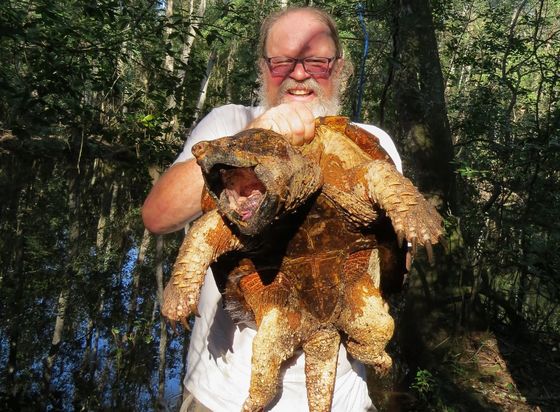 George Heinrich with Suwanee alligator snapper (Dirk J. Stevenson)
George Heinrich will go to great lengths, and depths, to draw attention to North America’s native turtles.
Even into an over-your-head blackwater bend in the Alapaha River.
Last month, Heinrich and Georgia naturalist Dirk J. Stevenson tread tea-colored water in a deep slough of the south Georgia river, testing the sluggish current, temporarily avoiding the swarming mosquitoes and probably toe-checking any available river bottom for a jagged shell that might reveal their targeted turtle: Macrochelys suwanniensis, the Suwannee alligator snapper.
It was all part of the Florida Turtle Conservation Trust’s Big Turtle Year. Heinrich and Tim Walsh of the Bruce Museum are trying to see as many of the United States’ 59 turtle species as possible in 2017.
The Alapaha trip brought them closer to their goal. ...
See our blog for the full story and photos.
Back to top.
 You probably know that DNR’s Nongame Conservation Section depends largely on fundraisers, grants and direct contributions.
You also may know that DNR’s eagle and hummingbird license plates are the leading fundraiser for the Georgia Nongame Wildlife Conservation Fund.
But what you likely don’t know is that while sales of these plates are edging up, annual renewals are going down.
That leaves fewer and fewer eagle and hummer plates on the road each year. Which means the base of support for conserving golden-winged warblers, parrot pitcherplants, northern yellow bats and hundreds of other species is eroding.
What you can you do?
If you don't have an eagle or hummingbird plate, please consider buying one.
If you do, renew it each year. The cost is only $25 more than a standard state plate, and $20 goes straight to the Nongame Wildlife Conservation Fund.
These plates not only look good, they do good work. And they show your support.
Now you know.
Questions or comments? Please email us.
Back to top.
 Oakleaf hydrangea (Terry W. Johnson)
By TERRY W. JOHNSON
Each fall, thousands of leaf peepers drive to north Georgia to enjoy Mother Nature's annual fall foliage show.
During this eagerly awaited extravaganza, a kaleidoscope of colors stretches across the countryside. Blotches of yellow, red and orange transform the landscape into a tapestry of color.
Nowhere else in the state can you enjoy a display of fall foliage of this magnitude. Nevertheless, you can enjoy a smaller yet still vibrant show in your backyard. …
Read the rest of Terry’s column for tips on adding fall color to your yard.
Terry W. Johnson is a retired DNR nongame program manager and
executive director of TERN, Nongame
Conservation’s friends group. Read more in the Out My Backdoor
library, on Terry's Backyard Wildlife
Connection blog and in his book “A Journey of
Discovery: Monroe County Outdoors.”
LEAF WATCH 2017
DNR’s State Parks and Historic Sites Division offers updates and viewing options.
Back to top.
 Trispot darter (Dave Neely)
Two darter species in the upper Coosa River basin do not need Endangered Species Act protection, but one does. The U.S. Fish and Wildlife Service announced that while populations of bridled and holiday darters are “stable (and) being conserved through existing regulations,” the trispot darter should be listed as threatened. DNR is part of a collaborative effort to assess and conserve these species and frecklebelly madtom, also petitioned for listing. The work, a priority in Georgia’s State Wildlife Action Plan, monitored key populations of bridled and holiday darters in Amicalola Creek and the upper Etowah and Conasauga rivers (“Searching for rare darters,” Sept. 21). Both species will remain a conservation focus in the state. Comments on the proposed listing of trispot darters are due by Dec. 4.
Barbour’s map turtle will not be federally listed either, the Fish and Wildlife Service said in a separate decision. The turtle is thriving throughout most of its range – the Apalachicola, Chattahoochee and Flint rivers and major tributaries.
Six Georgia projects to restore wildlife habitat and water quality will receive grants from the National Fish and Wildlife Foundation’s Five Star and Urban Waters Restoration Program. The projects vary from creating a corps of young conservation stewards in Athens to restoring floodplain along Atlanta’s Proctor Creek and marshline and a tidal creek at Savannah State University.
Deer hunting is here, with primitive weapons season
opening Oct. 14 and modern firearms Oct. 21 (season details). While deer hunters are
required to wear at least 500 square inches of daylight fluorescent orange
above the waist during gun seasons, the same is recommended for hikers, birders
and others in the field.
The Outdoors GA app has multiple uses for all who enjoy the
outdoors, whether its checking regulations, buying a lands pass or finding
nearby wildlife management areas. The free app is available for iPhones and
Androids.
Back to top.
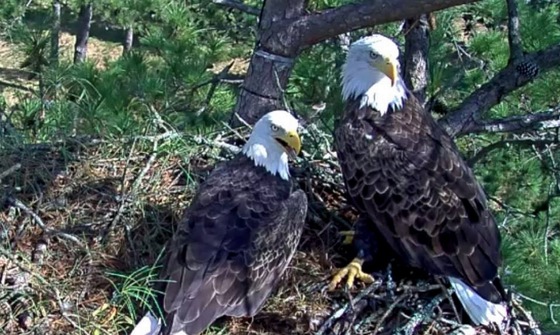 Berry College nest cam screenshot
The bald eagles streamed by Berry College
are sprucing up their nest and The Landings cam has videoed great
horned owls in the nest ospreys used this year. Watch these and the Go Fish Education Center aquarium cam at www.georgiawildlife.com.
When it comes to reptile and amphibian diversity,
three of the top six Defense Department installations are in Georgia. Fort
Stewart is No. 1 with 100 species, Fort Gordon is fifth (76 species)
and Fort Benning is sixth (74 species), according to the "first
comprehensive review" of the department’s 415 sites.
Hurricane Irma brought an abrupt end to Georgia’s
sea turtle nesting season, and about unhatched 300 nests. It is likely some turtles had hatched but not emerged from the nest – and the water helped them to the surface
– while the state's more than 2,140 loggerhead nests still marked a strong
season.
Georgia teachers, take note: Oct. 16 is the deadline to apply for DNR’s $1,000 Conservation of the Year grant,
available for 3rd- through 5th-grade educators in life
sciences and funded by The Environmental Resources Network, or TERN, the Nongame Conservation Section's friends
group.
Women can learn outdoor skills
including hunting and fishing, and even see what it’s like to tag alligators,
in the Beyond BOW program Dec. 8-10 at Okefenokee National
Wildlife Refuge, "land of the trembling earth."
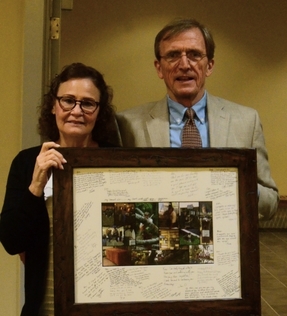
Names
in the news: The Georgia Conservancy will recognize Gov. Nathan Deal as 2017
Distinguished Conservationist during the conservancy’s 50th
anniversary ecoBenefete in Atlanta Oct. 12. DNR Law Enforcement Division
Director Col. Eddie Henderson has been elected president of the National
Association of Conservation Law Enforcement Chiefs. Nongame Conservation
Section’s Ken VanHoy, who just retired from a do-it-all 15-year career that varied from
setting up the peregrine falcon camera to working prescribed fires and
replacing truck brakes, was honored with his wife Patsy (both at right with a photo collage signed by staff) during a dinner at Charlie Elliott Wildlife Center.
Back to top.
|
"North Atlantic right whales died of blunt force trauma, entanglement, necropsies confirm," Canadian Geographic
"Green innovators honored" (includes Raccoon Creek project), Georgia Trend
"Pelican chicks on Georgia coast road out Irma," Athens Banner-Herald
"$1,000 DNR grant available for top conservation teacher," The Covington News
"East Georgia TriBeta and Swainsboro Middle School SciFries team up in bog garden," East Georgia State College
"Irma destroyed all Everglade snail kite nests at Okeechobee," Audubon
"11-foot alligator dies after getting caught in tire," WXIA-TV (Ch. 11, Atlanta)
"National parks struggle with mounting crisis: too many visitors," New York Times
"Botanic gardens 'best hope' for saving endangered plants," BBC
"Sea turtles appear to be bouncing back around the world," New York Times
VIDEO AND AUDIO
Gopher tortoise hatchling at Altama Plantation WMA
(audio) "Clean nest boxes in October," BirdNote
Back to top.
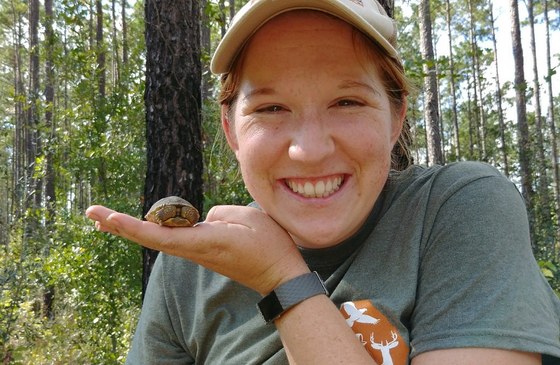 .
 In snapshots from the field, wildlife technician Emily Ferrall (above) helped the Nongame Conservation gopher tortoise crew with surveys at Moody Forest Wildlife Management Area and Southern Co.’s Edwin I. Hatch Nuclear Plant near Baxley. One find at Moody was this hatchling tortoise. Bottom left, wildlife tech Marylou Moore also found a juvenile tortoise by its juvie-sized burrow at Ohoopee Dunes WMA. Bottom right, Andy Day, a wildlife technician, and naturalist Dirk J. Stevenson checked and released a 9-pound, 7-foot-plus eastern indigo snake in Irwin County. For a change of pace, at right are unusual the Indian pipes senior wildlife biologist John Jensen spotted in Jasper County. The plants are usually pure white.
|
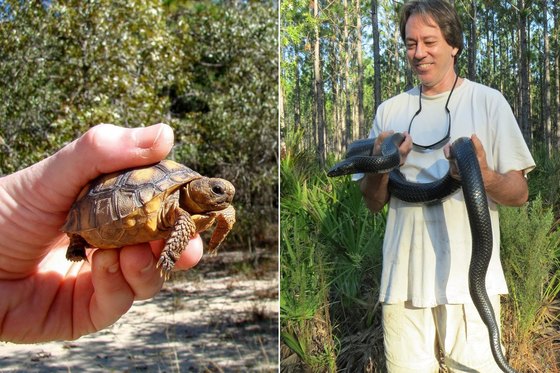
Masthead image: fall colors at Cohutta Wildlife Management Area
Back to top.
|